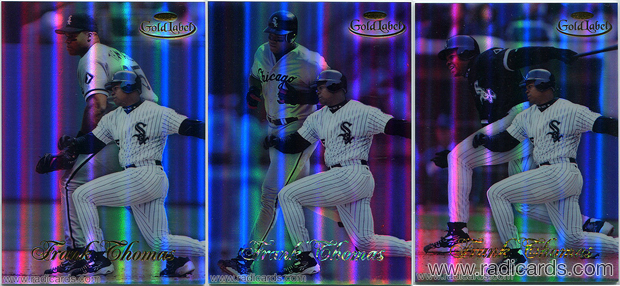
1998 Topps Gold Label can be a challenging product to collect if you don’t know what’s what. It took me some time before I figured out what was what with this set since Topps didn’t clearly state the class identification on the cards. Luckily, they fixed this in 1999.
Let’s makes some sense of the 1998 issue. Here’s what you need to know:
- Class 1
: This class features the player in a fielding pose in the background. The text on the card is flat gold foil. Common.
- Class 2
: This class features the player in a running pose in the background. The text on the card is silver sparkle foil. Uncommon. Insertion ratio: 1:2
- Class 3
: This class features the player in a batting pose in the background. The text on the card is gold sparkle foil. Rare. Insertion ratio: 1:4
Each class comes in 4 different versions for a total of 12 different cards per player. Here’s the rundown:
- Gold Label
: This is the base card; it has a flat gold foil label. Common.
- Black Label
: The label on these is black. Uncommon.
- Class 1: Insertion ratio: 1:8
- Class 2: Insertion ratio: 1:16
- Class 3: Insertion ratio: 1:32
- Red Label
: The label on these is red and each class comes with a different print run. Rare.
- Class 1: Print run of 100. Insertion ratio: 1:99
- Class 2: Print run of 50. Insertion ratio: 1:198
- Class 3: Print run of 25. Insertion ratio: 1:396
- One to One
: These are the most difficult to find. Only one set was printed, which makes each card a 1/1. Insertion ratio: Unstated. Ultra rare.
To see what’s currently on eBay from 1998 Topps Gold Label, click here.
Set Information:
1998 Topps Gold Label is a 150-card set issued in 3-card packs with an SRP of $3.00 and came 24 packs per box and 8 boxes per case. 5-card HTA packs were issued with an SRP of $5.00.
Asterisks have been included next to the Odds ratios for the Class 1 One of Ones because the odds of pulling this parallel in both Class 2 and 3 use this same ratio. Since no odds ratio confirmation exists for Class 1, it makes sense to assume the same odds with that class too.
| Set | Total Cards | Print Run(s) | Odds |
|---|---|---|---|
| Class 1 | 100 | – | – |
| Class 1 Black | 100 | – | 1:8 |
| Class 1 Red | 100 | 100 | 1:99 |
| Class 1 One to One | 100 | 1 | 1:1085* |
| Class 1 Black One to One | 100 | 1 | 1:1085* |
| Class 1 Red One to One | 100 | 1 | 1:1085* |
| Class 2 | 100 | – | 1:2 |
| Class 2 Black | 100 | – | 1:16 |
| Class 2 Red | 100 | 50 | 1:198 |
| Class 2 One to One | 100 | 1 | 1:1085 |
| Class 2 Black One to One | 100 | 1 | 1:1085 |
| Class 2 Red One to One | 100 | 1 | 1:1085 |
| Class 3 | 100 | – | 1:4 |
| Class 3 Black | 100 | – | 1:32 |
| Class 3 Red | 100 | 25 | 1:396 |
| Class 3 One to One | 100 | 1 | 1:1085 |
| Class 3 Black One to One | 100 | 1 | 1:1085 |
| Class 3 Red One to One | 100 | 1 | 1:1085 |
| Home Run Race | 4 | – | 1:12 HTA |
| Home Run Race Black | 4 | – | 1:48 HTA |
| Home Run Race Red | 4 | 61 | 1:4055 HTA |
| Pre-Production | 3 | – | Wholesale/Retail Dist. |

 Have you visited our store? Click here.
Have you visited our store? Click here.



the one to one’s are 1:9900 packs. Extrapolate the odds from each of the red labels. 😉
Wow! Was that insertion ratio stated on the packs? Also, wouldn’t the odds for any 1/1 be the same? Interesting thoughts.
They 1/1’s are all the same pack odds.
Class 1: 100*99 = 9,900 packs
Class 2: 50*198 = 9,900 packs
Class 3: 25*396 = 9,900 packs
See how the print runs keep halving and the odds keep doubling on the red labels?
If you do that enough times eventually you will get to 1 print run and 9,900 packs.
I see the logic now. Excellent feedback on this one. Thanks, Steve.
If the last comment was not clear, this maybe easier to understand.
take the number of packs and divide by the print run…..
9,900 /1 = 9,900
9,900 /2 = 4,950
9,900 /3 = 3,300
9,900 /4 = 2475
9,900 /5 = 1980
…………..all the way down to:
9,900 /25 = 396
9,900 /50 = 198
9,900 /100 = 99
^^^ You’ll notice these are the red label print runs and packs odds.
That’s hugely helpful. 🙂